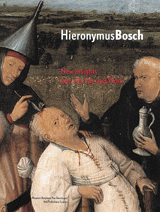
Van Gangelen/Ostkamp 2001
“Parallels Between Hieronymus Bosch’s Imagery and Decorated Material Culture from the Period Between circa 1450 and 1525” (Hans van Gangelen and Sebastiaan Ostkamp) 2001
[in: Jos Koldeweij, Bernard Vermet and Barbera van Kooij (eds.), Hieronymus Bosch. New Insights Into His Life and Work. Museum Boijmans Van Beuningen-NAi Publishers-Ludion, Rotterdam, 2001, pp. 152-169]
The authors of this contribution base their interpretation of a number of Bosch’s works on the material culture from the period around 1500. By referring to contemporary ornamental objects and utensils, but also to prints, paintings, mural paintings, misericords and literary texts they attempt to show that quite a number of motifs painted by Bosch also appeared elsewhere. Sometimes these parallels remain rather superficial, for example when it is proven that a certain kind of pitcher painted by Bosch also existed in late medieval reality (confirmed by archaeological findings). In most cases the detection of thematical parallels between Bosch and the material ornamental culture around 1500 leads to the observation that Bosch often depicted the motif of the omgekeerde wereld (the world upside down). From this the authors conclude that Bosch was a ‘child of his time’ and that a lot of his motifs can be traced back to an older tradition.
This contribution provides us with some interesting facts but unfortunately its structure is also rather incoherent and this does not do any good to the clarity and the strength of the argument. The interpretations of certain details in Bosch’s works are not always convincing and sometimes tend to jump to conclusions. Examples are: the suggsted parallel between the man with a donkey and a monkey on top of it on the central panel of the Adoration of the Magi triptych (Madrid) and the Flight to Egypt [p. 157], the identification of the three women in the bottom left corner of the central panel of the Haywain triptych (Madrid) as ‘mothers’ (it are actually two gypsy women deceiving a middle-class lady) [pp. 157-158], the suggested parallel between the man carrying a sack on his shoulders in the Invidia segment of the Prado Tabletop with the Seven Deadly Sins (Madrid) and a lead-and-tin badge showing a miller on horseback and a windmill [p. 167], and also the suggested likeness between the person on a barrel in the Gula fragment (New Haven) and a figure depicted on a pitcher who also happens to blow a horn (actually there is no similarity at all) [p. 169]. Sporadically iconographical details are described in a wrong way. An example: on the left half of the central panel of the Haywain there is no man peeking under the skirts of a nun (these figures are a male and a female beggar) [p. 166].
Conclusion: the information in this article about late medieval ornamental culture and utensils provide us more than once with interesting material for the interpretation of Bosch’s works (just two examples: in late medieval iconography figures standing on their head often refer to the World Upside Down and signal that what is going on in their immediate surroundings is ‘upside down’ (wrong) [p. 159], and badges showing a vagina within a mussel shell are proof of the erotic symbolism of mussels around 1500 [p. 162]. When the authors themselves start to interpret Boschian motifs, one has to be on the alert, though.
[explicit]